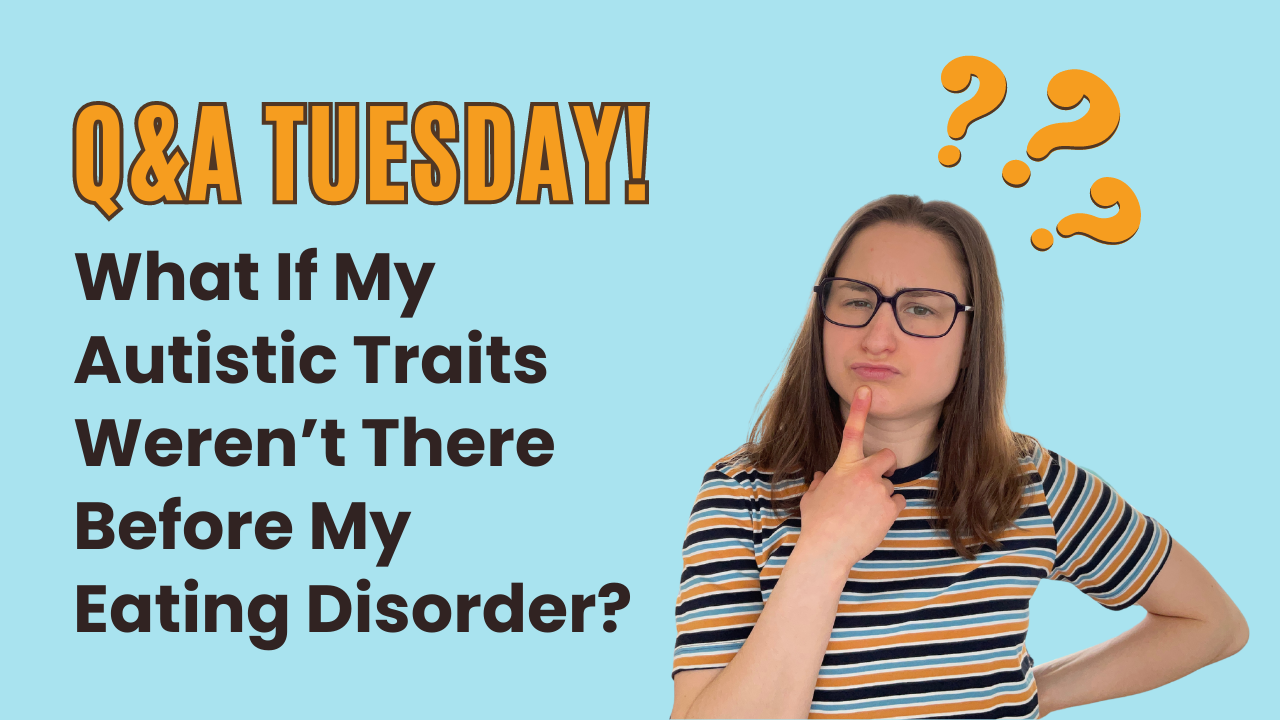Q&A: What If My Autistic Traits Weren’t There Before My Eating Disorder?
Mar 27, 2023
Hello and welcome to Liv Label Free Q&A Tuesday! Yep I’m starting a new series on the blog in which I will be answering YOUR questions Q&A style! And because I absolutely love semantics and when things rhyme because then they just make more sense to me in my head, I’m naming this series Q&A Tuesday :)
If you’re a frequent reader of the blog or have at least read to my posts "3 ED Behaviors That are ACTUALLY Autistic Traits part 1 and part 2 (and yes there will be a part 3 and part 4 at some point!), you know that I believe my eating disorder was simply a manifestation of undiagnosed autism, and thus, certain “eating disorder behaviors” were merely manifestations of autistic traits.
Book updates...
If you’re interested in reading my FULL story of how growing up undiagnosed autistic led to an almost decade-long battle with an eating disorder and how discovering I’m autistic was the KEY to full recovery, be sure to get on the waitlist for my memoir Rainbow Girl! If you are on that list, you’ll be the first to hear updates and when the book is out in the world! And speaking of books, my cookbook Nourishing Neurodiversity is officially published and is available as an eBook, a paperback, and after several requests, a hardcover!
Nourishing Neurodiversity is filled with over 50 easy recipes that are vegan, gluten-free, soy free, nut-free, AND 100% customizable to fit YOUR unique needs + preferences. Unlike most recipe books that are cookie-cutter (no pun intended!) and don’t accommodate each individual’s sensitivities and health issues, Nourishing Neurodiversity offers endless tips on how to make the recipes fit into YOUR life so that you can literally nourish your neurodiversity! It’s also filled with little tips and facts throughout, including tips on how to heal digestive issues, optimize gut health, and improve executive functioning!
Last order of business before we dive into today’s blog is that you can get all of my books for FREE by becoming a Liv Label Free Patron which is also the best and easiest way to support the podcast and support me as a creator so I can continue bringing you free value and answering your questions. Podcast episodes and blog posts and YouTube videos and Instagram content may seem like quick, small, bite-sized pieces of information, but they require a LOT of time, energy, and commitment to create content and I would be so so grateful if you can show your support and love for me by joining me on Patreon! When you click HERE you’ll see the option to donate however little or much as you believe my content is worth to you <3 With all that said, let’s dive into our very first Q&A Tuesday!
Today's question:
Today’s question comes from Alexandra who writes:
First of all, thank YOU Alexandra for your kind words and for this excellent question! I’m sure so many other readers are wondering the same thing and that’s exactly why I decided to answer the question publicly on the blog, so that everyone can read my answer :)
The root of ED behaviors
I want to start by pointing out that all “ED Behaviors” that are rooted in autistic traits are exactly that – rooted in autistic traits. The behaviors themselves are not inherently autistic traits, but rather manifestations of something deeper. To explain what I mean in context, let’s reflect back on one of the traits I mentioned in my first post titled ED Behaviors that are ACTUALLY Autistic Traits: attaching numbers to food/exercise.
As I explained in that post, autistic people tend to attach numbers to many things! I attached an excessive amount of value to my grades at school, the scores I received in sports, and even now, I like to stick to a similar daily routine of doing specific activities at certain times. In this case, the root autistic trait is attaching numbers and it can manifest into several different types of behaviors. During my eating disorder, this trait obviously manifested into behaviors around food and exercise, which then, paired with other autistic traits such as obsessiveness, perfectionism, and desire for ritual and routine, became a dangerous and isolating existence.
"New" autistic trait?
Before I got an eating disorder, I obviously did not count calories or force myself to run a certain number of miles each day. So going back to Alexandra’s question, would this attaching of numbers to food and exercise be a “new” autistic trait?
No. Because the root of the behavior – the autistic trait of attaching numbers to things – isn’t new. The behavior is new, or better said, the autistic trait took on a new manifestation. This goes for all the other traits as well. To unpack another one, let’s take the behavior of smoothing out food.
The reason I always make sure the peanut butter jar or container of yogurt or ice cream is “smoothed out” is because it gives me a sense of perceived completeness and visual satisfaction. So here, the root is the autistic trait of need for things to be completed and visually appealing. Or as I always tell my mom, things just need to “make sense” in my mind.
I do not remember engaging in this behavior before my eating disorder, which again begs the question, is this a new autistic trait? But then again, no. Because my need for that completeness and desire for things looking a certain way has been a trait I’ve had all my life. The trait just took on a new expression during and after my eating disorder.
How can this help in ED recovery?
So far, we’ve talked about why autistic traits themselves aren’t the same as specific behaviors, but how autistic traits may simply manifest as certain behaviors. But why is this important and how can you use this knowledge to help you recover from your eating disorder?
Because when you know that the root of the behavior is autism and not the eating disorder, you can work with the trait in a way that aligns with you as a person. For example, understanding that the behavior of attaching numbers to food and exercise is rooted in a desire to attach numbers to aspects of life in general, rather than just being a surface-level ED behavior, you can take a step back and ask if there are other ways in which you want this trait to manifest in ways that are NOT detrimental to your health.
As I mentioned in my first post on this topic, it may be very helpful to set an increased minimum number of calories to ensure you meet your unique nutritional needs, or to set a maximum amount of minutes that you move a day to challenge your exercise compulsions. In both these cases, you’re embracing your autistic trait of number attachment, but no longer allowing it to manifest into an eating disorder behavior.
And there you have it, my answer to today’s Q&A Tuesday! If you want to learn more about how you can embrace your autistic traits to fully recover from disordered eating, I have a completely FREE audio training called 3 Steps to Recovery From an Eating Disorder as an Autistic Person! It’s a super practical, step-by-step 45 minute training that’s honestly like a private coaching session with me on demand in which I guide you through 3 actionable, yet simple steps to use autism to your advantage in ED recovery. You can listen to the training right now by clicking HERE and it will be delivered straight to your inbox! And if you have a question you’d like me to answer for a future Q&A Tuesday, be sure to submit your question via the contact form. I can’t wait to hear from you soon!





